Augmented Reality App Development: Extensive Guide
Augmented reality is the technology that has been gaining traction over the past few years. We’ve seen a number of applications making billions in the market. Pokémon Go is a great example.
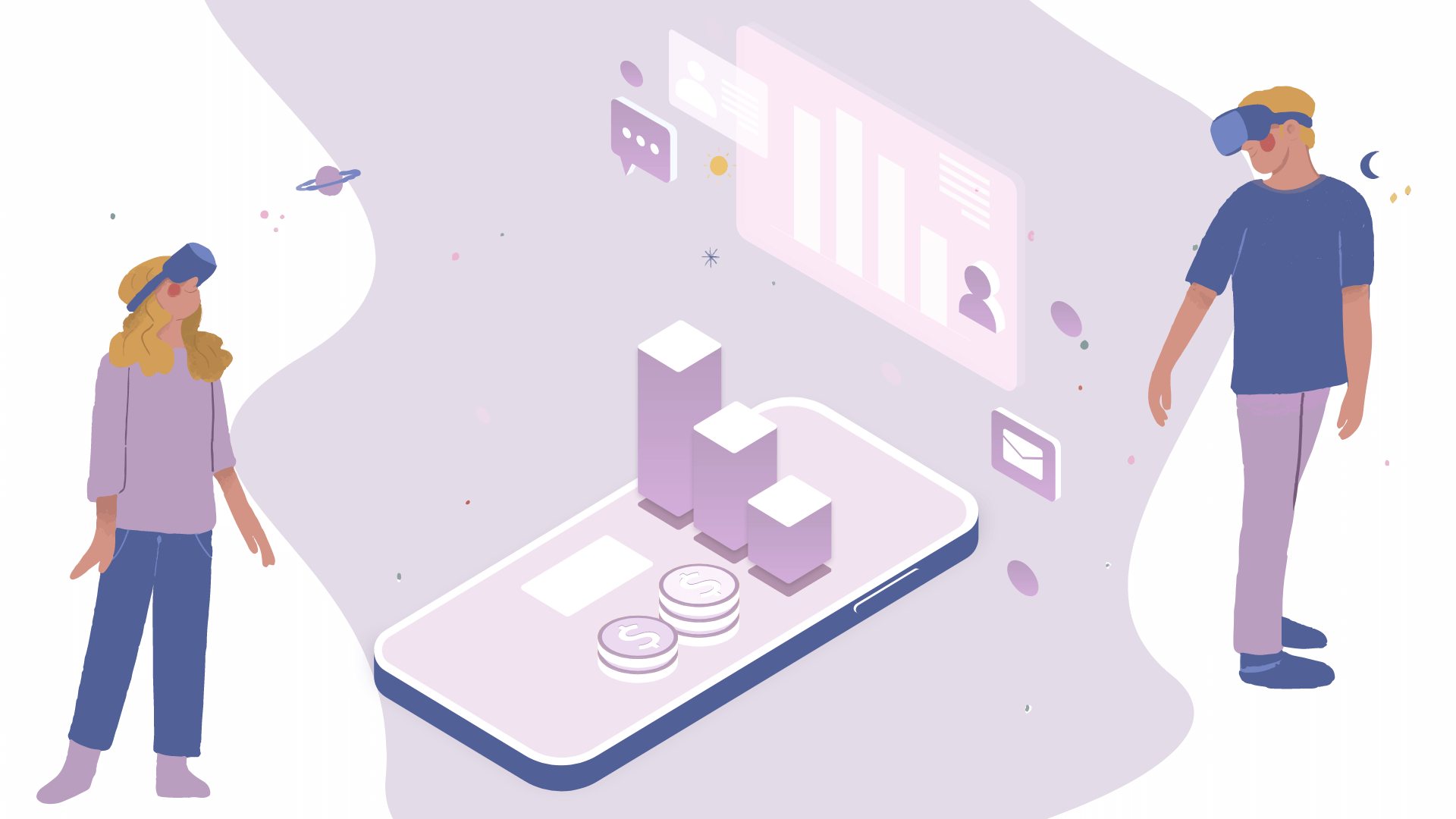
The market of AR solutions valued at USD 42.20 billion in 2022 and is projected to reach USD 1,109.71 billion by 2030, exhibiting a CAGR of 50.7% during the forecast period. North America augmented reality market was evaluated USD 13.72 Billion in 2022.
You probably wonder how to make an augmented reality app or add such functionality to your application. This article is an exhaustive guide on augmented reality app development, covering all the points of the whole process.
Here is a quick sneak peek of what’s waiting for you inside:
- How Addevice can help you build an augmented reality app
- What AR is and how it’s different from VR
- Key types of augmented reality apps
- Augmented reality tools
- Industries where AR can save the scene
- Step-by-step guide for augmented reality mobile app development
- AR development cost
Let’s uncover how to make an augmented reality app that will be a success in the future.
Addevice's Experience in Augmented Reality Mobile App Development
Before we move on, let us tell you how Addevice can help you build an augmented reality app. This article is written based on our experience in augmented reality development. Our experts have successfully developed and released several AR applications, one of them being Fitle.
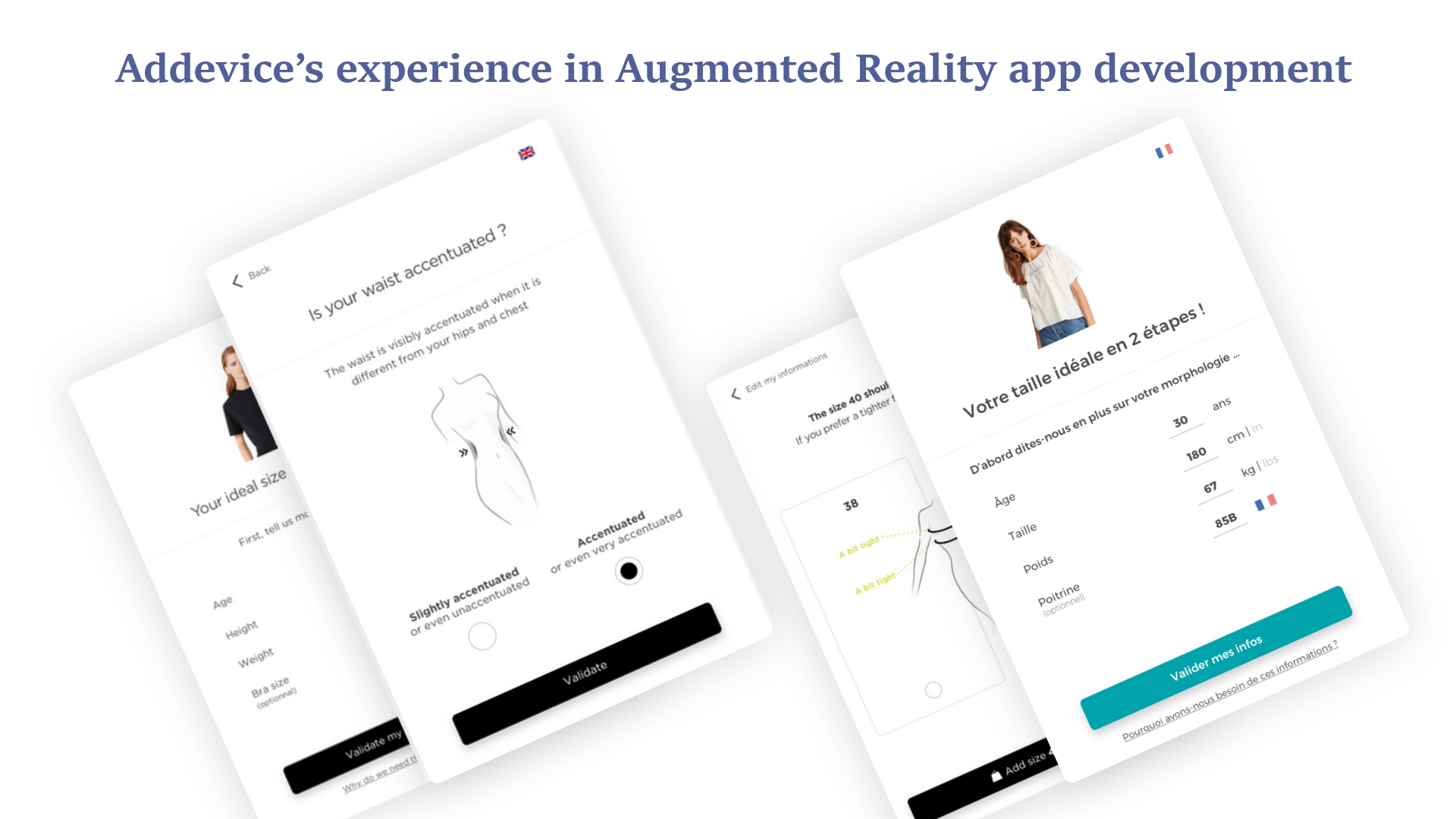
Fitle is a smart shopping application revolutionizing how consumers buy clothes. In the reality of COVID-19, this application offers a unique opportunity for a real-life-like shopping experience for online buyers. The application allows customers to try on clothes without visiting shops.
The application uses the combination of a photo depth calculator and an augmented reality solution to compress photos into AR objects. The object is analyzed to determine exact body measurements and generate a 3D model. We combine the technology with high-security standards to create a safe environment for customers to try clothes on.
What is Augmented Reality?
Before we uncover how to make an augmented reality app, let’s first get a better understanding of what augmented reality technology is.
Augmented reality can be seen as a link between "virtual" data and the real world. It must have the following three characteristics:
- Combine the real world and virtual data in real time
- Be interactive in real time (a change in the real plane entails an adjustment of the virtual data)
- "See" the world around us in 3D (because we live in three-dimensional space)
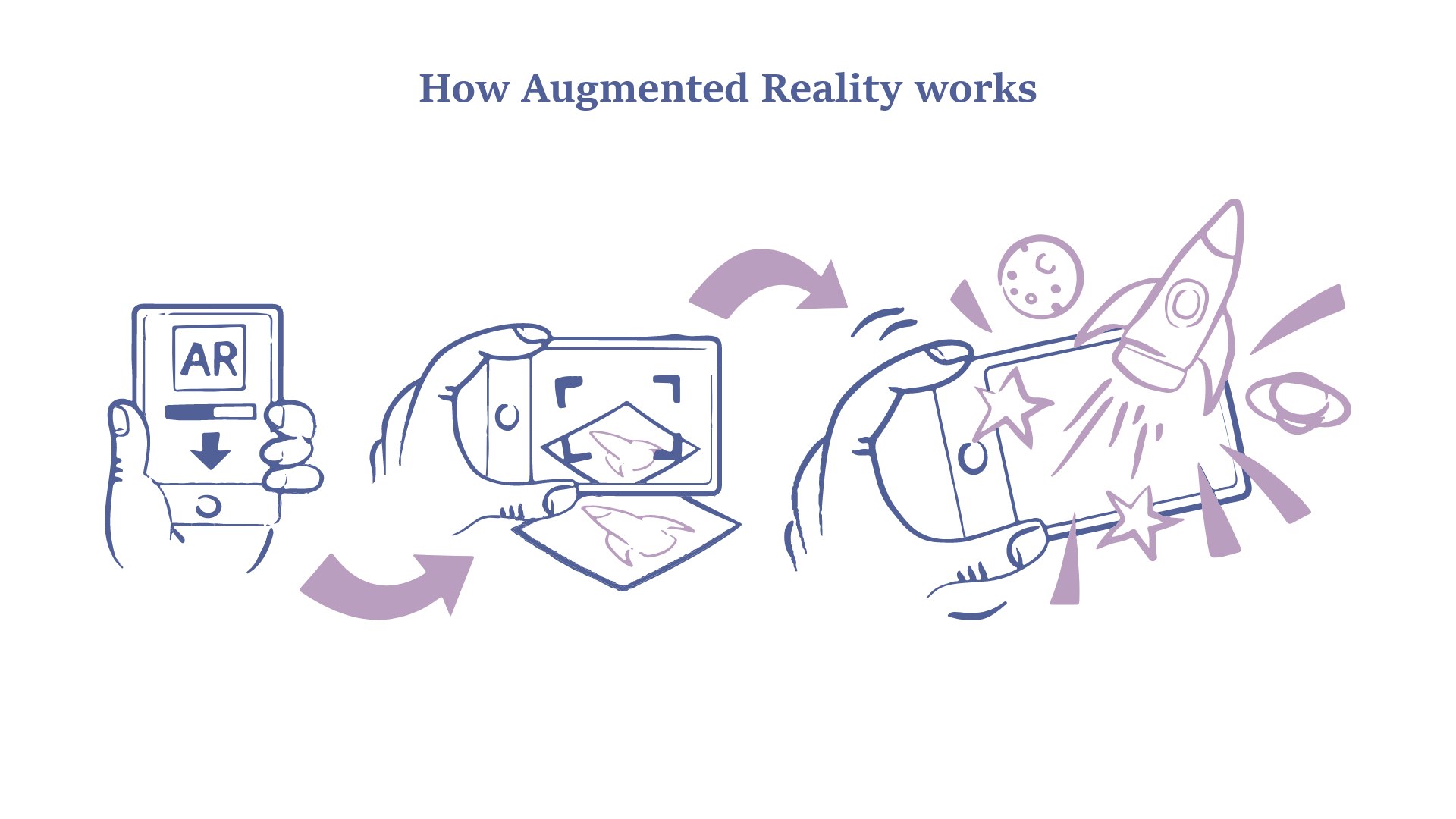
AR technology is already widely available to end-users. All they need to experience AR is a smartphone with a camera. Examples of such solutions are numerous, including Pokémon Go, IKEA Place, Sephora, and many others.
Virtual reality is another technology that is often confused with augmented reality. While their concept might be similar, they are very different in nature.
In AR solutions, 2D or 3D objects are projected into real-life environments. Virtual reality creates a virtual environment into which users can immerse with the help of VR headsets or glasses.
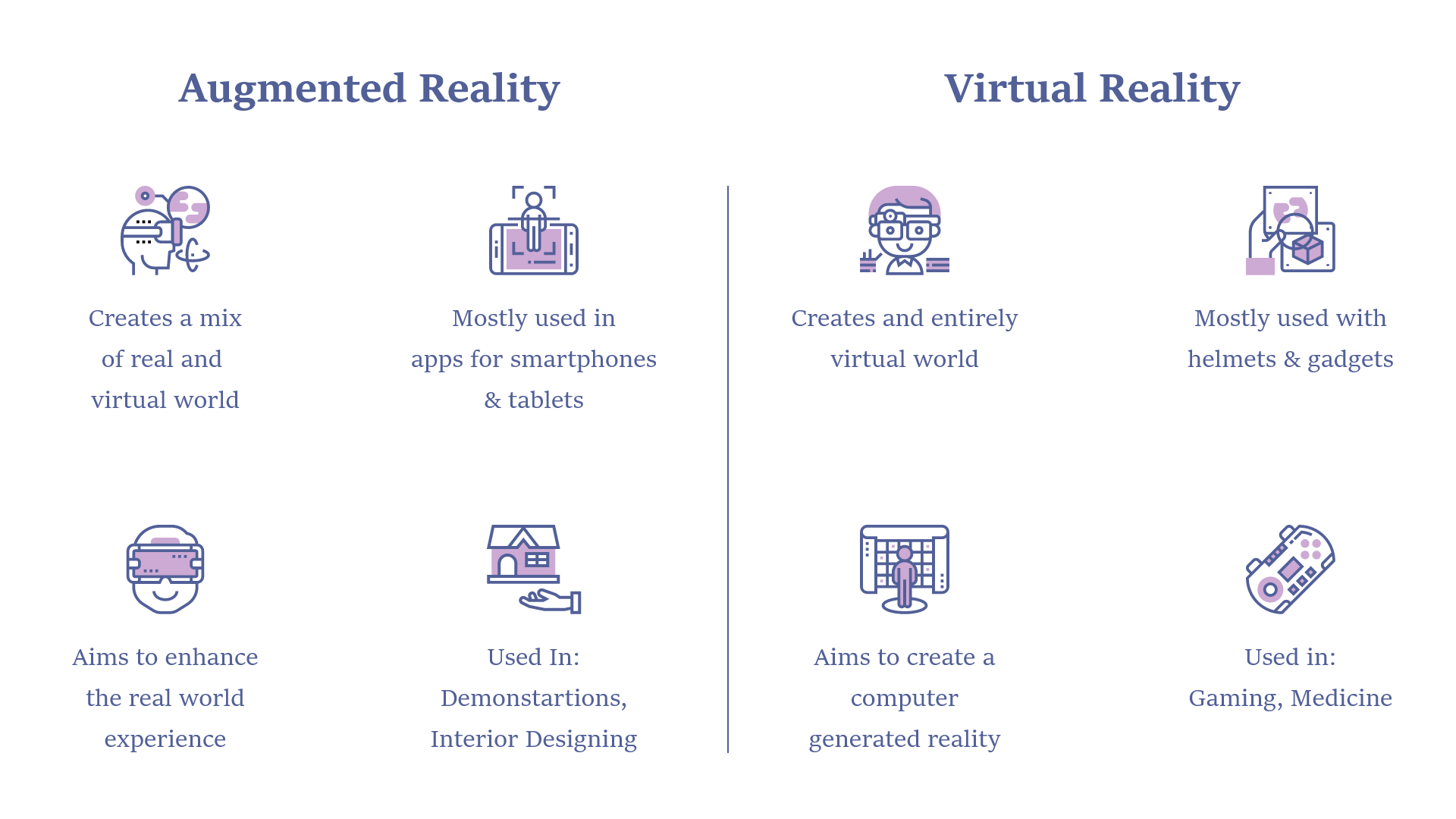
We talk more about the work of different augmented reality applications based on their type in the next chapter.
Types of Augmented Reality Apps
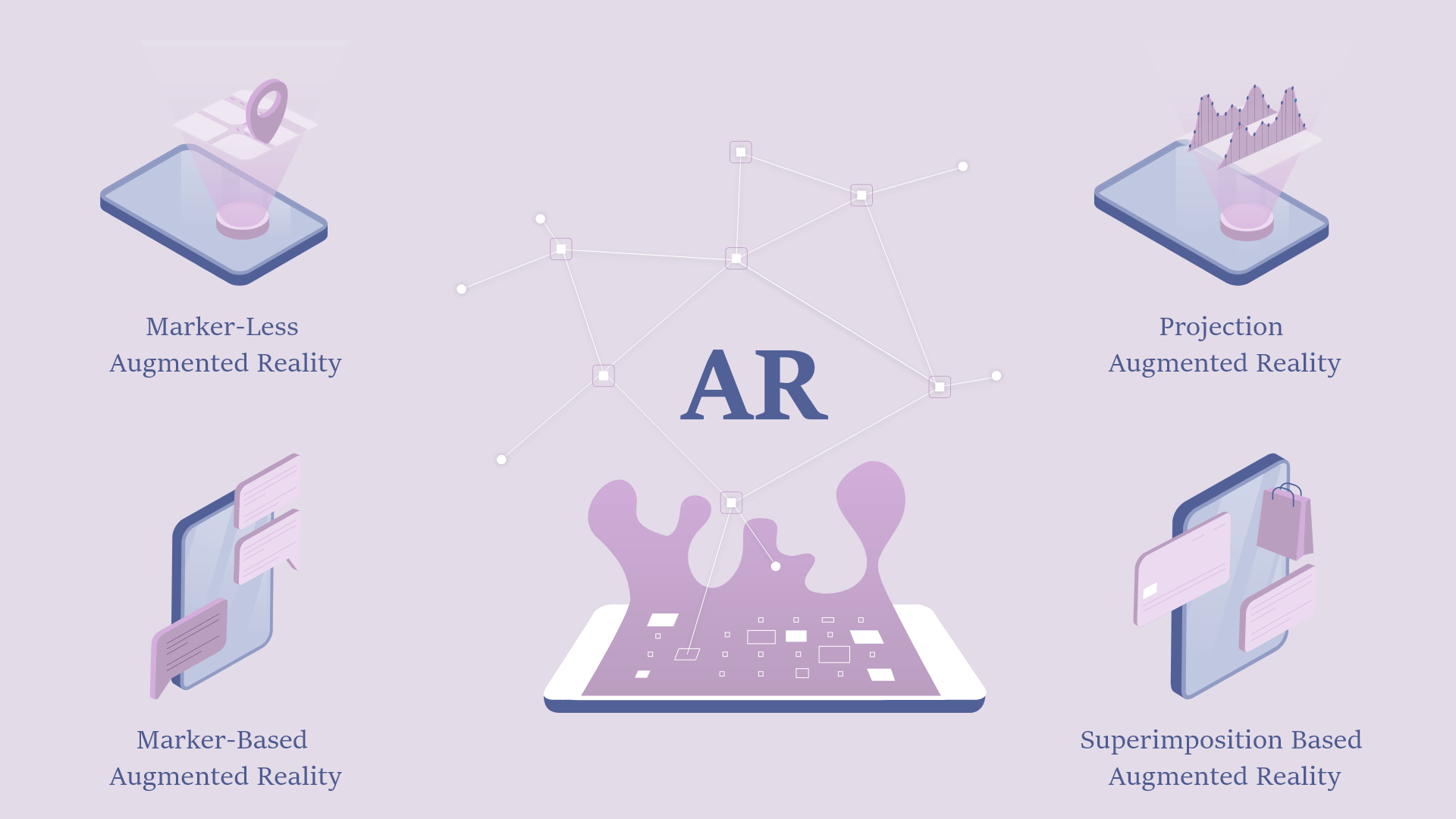
Augmented reality app development can take a number of forms depending on the business goals you are pursuing with your application. Let’s take a look at the main types of AR solutions:
- Marker-based augmented reality
- Location-based augmented reality
- Projection augmented reality
- Superimposition-based augmented reality
Below, we identify how they differ and which technologies are used to build each of them.
Marker-Based Augmented Reality App
This type of AR application is based on image recognition or image markers. Once the application detects an image or object that it can recognize, it overlays digital information on the marker.
Such solutions can use 3D or non-3D objects, such as QR codes, as markers.
Location-Based Augmented Reality
Location-based AR solutions, also known as marker-less AR, are the most widely used implementation of augmented reality. Instead of using markers, such apps use GPS, accelerators, compasses, and other location detectors to create AR objects based on the current location. Pokémon Go is a great example of this type of application.
Projection Augmented Reality
Applications of this type rely on visual odometry. They use complex algorithms and collect data from multiple sensors to identify objects’ precise location and perform respective actions.
Projection AR can be used as a part of the car parking system since it can show hidden objects from built-in cameras. Architects and engineers can also use this technology to better study the environment for placing constructions.
Superimposition Based Augmented Reality
Applications relying on superimposition are used in healthcare and medicine. The technology is self-explaining. A real image of the environment is processed, recognized, and overlaid with an AR object.
Best Tools to Build Augmented Reality App: SDKs & Tech
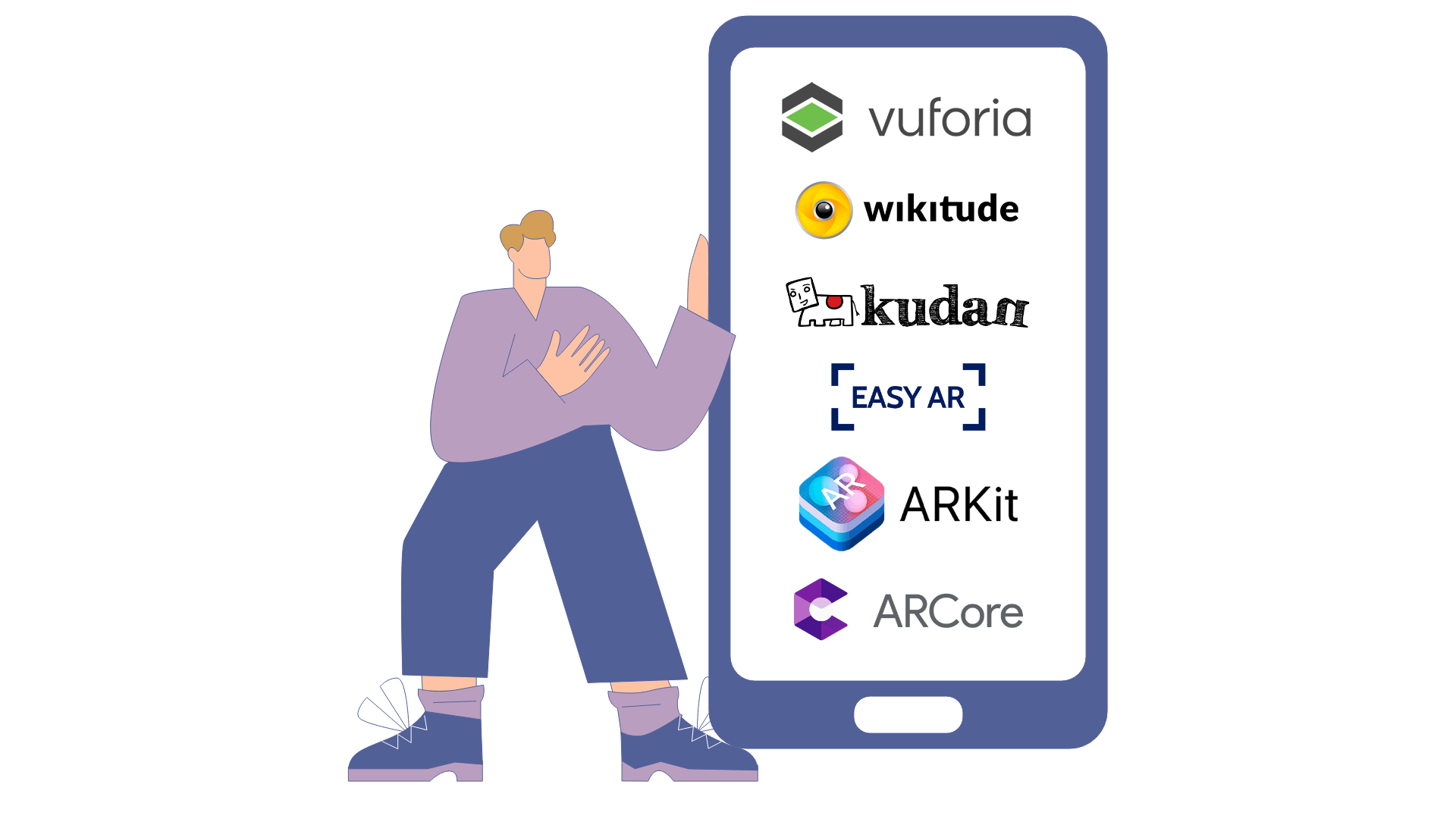
It’s impossible to decide how to make an augmented reality app without knowing which technologies can be used for such a task.
Augmented Reality software development SDKs are tools designed to help developers build augmented reality apps faster and without developing components created by other companies.
Let’s overview augmented reality development tools that your application can rely on.
To choose the best SDKs that will align with your business targets, you need to pay attention to the following factors:
- Native support for AR
- The operating platform it’s targeting
- The programming language in which it’s written
- Official SDK support
- License and monetization
Knowing such details about SDKs, you will be able to choose the best solution that will not require you to pay a huge sum for use and which will not limit the augmented reality app development process.
Vuforia
Vuforia is one of the most popular augmented reality development SDKs that enable companies to deliver immersive AR experiences to their customers. Thanks to its API accessibility through Unity, Vuforia can be used to develop native apps for iOS and Android. It is also considered a complete SDK with rich feature set for AR applications.
- Real-time identification and tracking of target images, English texts and 3D objects
- Placing virtual objects such as 3D models in a real environment
- Multipurpose 3D configurations
- Vuforia Engine Area Targets with Area Target Generator
- Scanned Model Targets
- Advanced Model Targets - Multiple Model Detection
- Continue working when paused applications
- Simulation mode
- Vuforia Engine Tracking Scale
Wikitude
Wikitude is used to develop mobile apps and AR prototypes. The new Wikitude SDK enables developers to implement geolocation capabilities as well as image tracking and object recognition. Some of its features include:
- 3D recognition and tracking
- Image recognition and tracking
- Cloud recognition
- Location-based AR
- Video overlay
- Smart glasses integration
- Integration with external plugins
Kudan
Kudan is another universal AR SDK, its main features are described below:
- Location and tracking requirements with and without markers
- 2D and 3D Image recognition
- Visual-SLAM
- Fusion Sensor - sensor for detecting white light sources
- Flexible integration
- Universal setting
- Unity SDK
EasyAR
This robust SDK offers a lot of functionality an extensive set of functionalities for augmented reality app development of different types:
- SLAM support
- 3D tracking
- Screen recording
- Cloud recognition
- Unlimited recognition queries
Apple ARKit
iOS augmented reality SDK by Apple aiming to help iOS developers add AR capabilities. The tool offers several useful features:
- Device motion tracking
- Camera scene capture
- Advanced scene processing
- Visual inertial odometry
- Plane detection (floors, tables, etc.)
- Lighting estimation
- Unity and Unreal engines support
Google ARCore
Google ARCore is one of the most popular SDKs for building apps for smartphones and tablets. Surprisingly, its AR apps are supported not only on Android but also on iOS devices, allowing cross-platform AR apps to be developed. ARCore is based on two elements: position tracking and object recognition. Some of its standout features include:
- Real-time illumination assessment
- Precise placement of virtual objects
- Easy tracking to create realistic objects
- Sizing and Locating Vertical, Horizontal, and Sloped Surfaces
- Tracking movement according to the position of the phone
| Vuforia | Wikitude | EasyAR | Kudan | Apple ARKit | Google ARcore | |
| Platforms | Android, iOS, UWP | Android, iOS | Android, iOS, UWP, macOS | Android, iOS, UWP | iOS | Android, iOS |
| License | Free, Commercial | Commercial | Free, Commercial | Free, Commercial | Free | Free |
| 2D recognition | + | + | + | + | + | + |
| 3D recognition | + | + | - | + | + | + |
| Smart glasses support | + | + | - | - | + | + |
| Unity support | + | + | + | + | + | + |
| Geolocation | + | + | - | - | + | + |
| SLAM | - | + | + | + | + | + |
| Cloud recognition | + | + | + | - | + | + |
Aside from SDKs, you will also need to use some standard technology for iOS or Android development, which is listed in the table below.
| Android | iOS | |
| Programming languages | Kotlin, Java | Swift, Objective-C |
| SDK | Android SDK | iOS SDK |
| Toolkit | Android Studio | Apple Xcode |
How Can Augmented Reality Be Used In Industry?
Augmented reality technology is finding its way into various industries. In the image below, you see the most promising use cases for AR technologies.
AR technology offers interesting business solutions. Its use in industry and large enterprises is a matter of several years, but you need to think about its implementation now. Let's figure out why.
- eCommerce
The technology is already actively used in eCommerce and retail. Examples are numerous and include such applications as Fitle developed by Addevice, IKEA app, and even Loreal. The use of AR in eCommerce is already showing the power of its technology since it improves the shopping experience. The technology will probably gain even more traction in eCommerce with the outbreak of the COVID-19 pandemic. Such apps can be used to help customers to try on clothes, make-up, see how furniture will look in their apartments, and much more.
- Healthcare
The use of artificial intelligence in healthcare and medicine has numerous implementations. Today, augmented reality tools for education are already actively used for students’ training, during surgeries and other procedures.
Microsoft HoloLens is used to provide doctors with detailed human anatomy understanding to perform better surgeries, tumor identification, blood flow visualization, etc.
- Tourism and travel
Another sphere of use is traveling and tourism. Instead of reading history, tourists could live through historical events by visiting certain locations.
- Entertainment and games
Entertainment is the most promising industry for augmented reality app development. Such solutions can bring an entirely different experience by allowing users to interact with virtual objects in the real world. Pokémon Go is the brightest example of AR games, which generated more than four billion in revenue over the years. We are yet to see some other successful names that will outperform this game.
- Education
If you wonder how to make an augmented reality app that will make a difference, look into education. AR-powered solutions allow students to see virtual objects in the learning environment.
One of the possible implementations uses unique markers inside books that trigger the display of multimedia content.
- Real estate and architecture
This is another industry that can benefit from AR technology. With the help of such applications, specialists can see how their buildings will blend in with the environment and showcase projects to clients and investors.
- Military
The history of augmented reality application development for military purposes started in 1992 by the U.S. Air Force Research Laboratory. Today, special goggles can be used, for example, to provide the military with data to help them with ground navigation.
The number of industries that can benefit from the use of AR is numerous, and we are going to see a lot of its technology implementations in the future.
How to Make an Augmented Reality App: Step-by-Step Guide
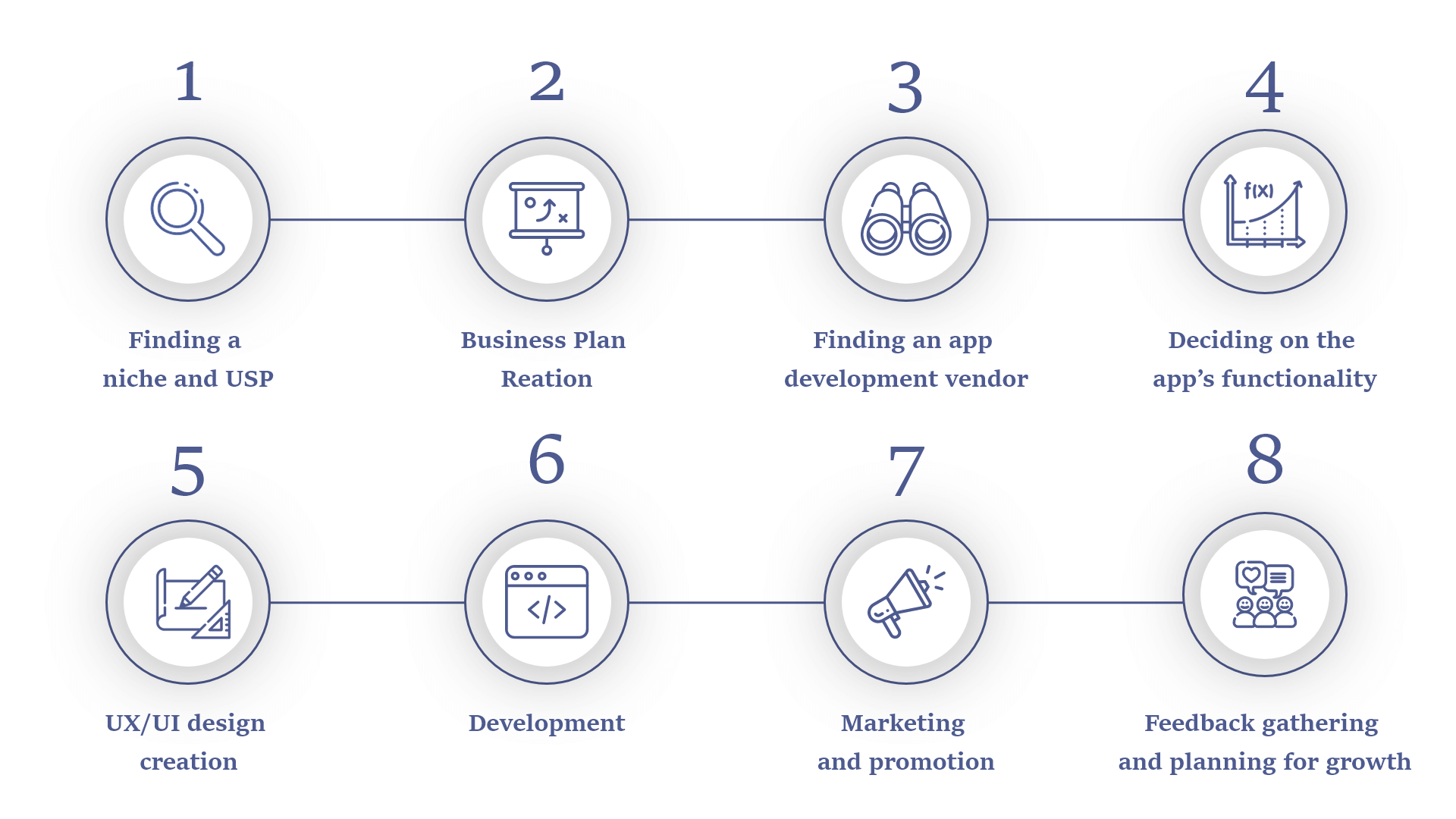
Here is an 8-step process to make an augmented reality app:
- Finding a niche and USP
- Business plan creation
- Finding an app development vendor
- Deciding on the app’s functionality
- UX/UI design creation
- Development
- Marketing and promotion
- Feedback gathering and planning for growth
Let’s learn how to make an augmented reality app in more detail.
1. Finding a Niche and USP
The first step of augmented reality app development is the vision creation for your future product. This is impossible without knowing your competition, market state, and which niches still have a place for new names. Your action plan can have the following steps:
- Market research – find out about the local market and which applications are popular there.
- Competitors research – learn who will become your competition, learn their strong and weak sides.
- TA research – make a comprehensive analysis of your target audience, its demographics, interests, income, and so on.
- USP creation – based on the collected data, decide which niche you will target and how your application will be different from the competition.
2. Business Plan Creation
After you identify how to make an augmented reality app that will be unique and meet user expectations, you need to create a comprehensive business plan. One of the steps is finding the right monetization model. Today, there are a few models that you can consider:
- Subscription – users buy a subscription for your application. You can provide them with different payment options, such as monthly, quarterly, or yearly subscription payments.
- Advertising – placement of advertisements inside your app can bring significant income. Ads blocking options can be provided at an extra payment.
- Freemium – allow users to enjoy some app features for free and ask them to pay if they want to enjoy full functionality
After you have decided on these matters, you can create a business model canvas to represent your value proposition, company infrastructure, customers, and finances.
3. Finding an App Development Vendor
The main secret behind successful apps is working with a reliable tech company that can create an augmented reality app. Below you can find some steps explaining how to make the right choice, so make sure not to skip any of them:
- Use such platforms as Clutch, The Manifest, and others to find a company providing augmented reality app development services.
- Experience and professionalism should come first; price should come second.
- Check clients’ reviews and shortlist companies
- Analyze vendors, compare their expertise, location, etc.
- Get in touch with shortlisted companies for an interview
- Decide on your future technical partner
The image below demonstrates the process of finding such a company.
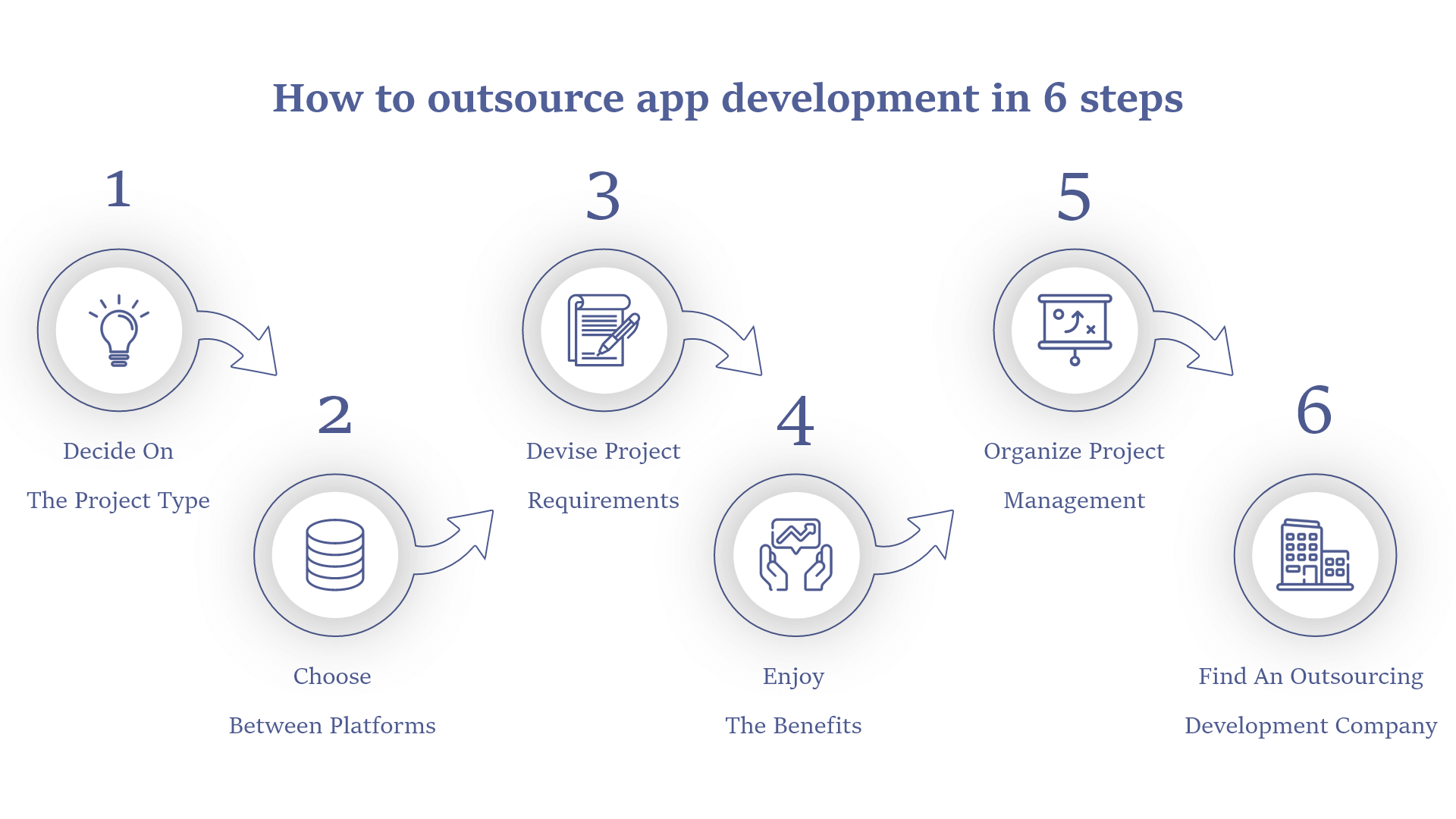
4. Choose App’s Functionality
This step is very important in augmented reality app development. Together with the vendor, choose the best functionality allowing you to build an augmented reality app according to your business needs. Aside from choosing SDKs and platforms, you might also need to implement some other features described in the table below.
| Service | APIs |
| Push notifications | Twilio Nexmo Plivo Apple Push Notifications Firebase Cloud Messaging |
| Payments | PayPal Stripe Braintree Apple Pay Google Pay |
| Navigation | Google Maps Google Places Google Maps |
| Mailing services | Gmail ZeroBounce Firebase Cloud Messaging SendGrid |
| Social media | Google Facebook Twitter Instagram |
5. UX/UI Design
Design creation is an inseparable part of the augmented reality apps development process. Together with designers, you will need to work on the user flows, branding, and unique style of your application at this stage. Just remember that a copycat solution won’t have a high chance of success. Thus, you need to aim for unique features and their unique visual representation in augmented reality app design.
6. Augmented Reality App Development
This is the central part of the journey you will endure to create your application. Your solution’s front-end and back-end parts are developed at this stage based on the produced design materials.
Each implemented feature and the technical solution must be thoroughly tested to avoid app performance, scalability, and reliability problems.
7. Marketing & Promotion
While the development process is underway, you can start working on your marketing strategy. The main goal here is to spark interest with your target audience by implementing the following marketing approaches:
- Paid ads – will help you get the first users of your application.
- SMM – social media is a place to create meaningful and trustworthy relationships with users.
- Influencer marketing – working with bloggers and influencers to connect with multi-million audiences.
- Content marketing & SEO – promotion of your AR application in Google search results through blog posts and other forms of content.
- Events – you can promote your app at live events, conferences, and meetings or become a special sponsor for some event.
- Partnerships – cooperate with other companies to promote your solution through their marketing channels.
8. Feedback Gathering & Growth Planning
Once your application is released to the market, start collecting customer feedback to learn what they think about your application and how it can be improved. After you have a full picture of possible improvements, discuss with your development team how they can be implemented with future updates.
Augmented Reality App Development Cost
You are probably wondering about the cost of building an augmented reality app.
If you decide to pursue the idea of augmented reality app development, you need to be ready to invest $60,000+ to create an app for a single platform (iOS or Android).
The final cost depends on several factors such as how many platforms you are targeting, to which country you outsource app development, which SDKs and functionality you will implement. The cost can reach $500,000 and even go far beyond this sum.
Augmented reality content creation can eat up a significant part of your budget, especially if you want to create real-life environments.
Augmented Reality, AR Apps, AR App Development, Streaming Apps, Healthcare in Mobile, App Cost Calculation, Wearable App Development, eLearning, Food Delivery App, Restaurant Mobile App, Learning Apps, Streaming Service Like Netflix, AR App Development
Develop Your Augmented Reality App
Step into the world of augmented reality with your own AR app
Our Expertise Covers:
✅ AR content creation and integration
✅ Marker-based and markerless AR experiences
✅ Customized features for a unique AR app
Table of contents
FAQ
The process of augmented reality app development can be organized into 8 steps:
- Finding a niche & USP
- Business plan creation
- Finding an app development company
- Choosing the app’s functionality
- UX/UI design
- Development
- Marketing & promotion
- Planning for growth
Please note that each of the above steps consists of different substeps. If you want to know how to make an augmented reality app, check our guide.
Augmented reality app development costs are estimated at around $60,000 for the first app version for a single operating platform (iOS or Android). With new functionality and new platform support, the cost will increase and reach $500,000+. You might need to invest a significant sum into creating 3D scenes and objects, depending on their complexity.
Augmented reality is a technology that overlays real-world environments with digital augmentation. Users can see a combined image of a real scene with virtual objects on it.
Pokémon Go is the most vivid example of AR implementation in the entertainment industry. Over four years of history, users spent over 4 billion dollars with this application. There are numerous other examples, such as IKEA Place, Sephora, Amazon AR Player, etc. AR technologies have already penetrated almost every industry, and their use is predicted to grow in the near future.
 TOP 8 trip planning apps 2024: Best trip organizers for you
TOP 8 trip planning apps 2024: Best trip organizers for you
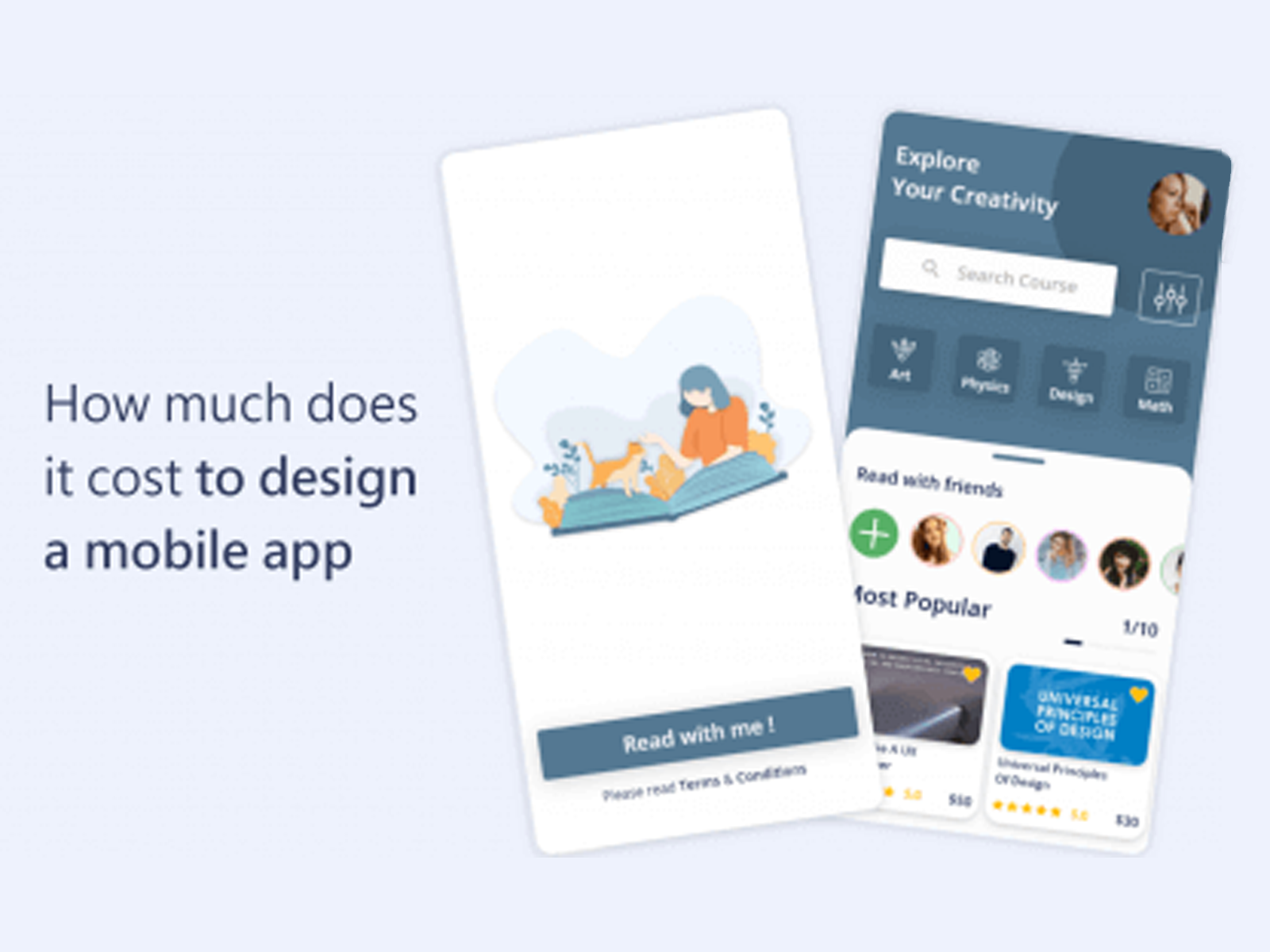 How Much Does It Cost To Build An App For your business In 2024
How Much Does It Cost To Build An App For your business In 2024
![How to Create a Workout App: Detailed Guide [Business & Tech]](/storage/uploads/blog_post/thumbnail_photo/63f7286077982_How to Create a Workout App.png) How to Create a Workout App: Detailed Guide [Business & Tech]
How to Create a Workout App: Detailed Guide [Business & Tech]